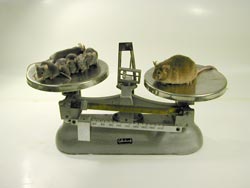Repeat act: Parallel selection tweaks many of the same genes to make big and heavy mice

One giant mouse weighs more than six 'mini-mice' of the same age. The biggest mice in the world evolved through targeted breeding over many generations. Scientists can use these animals to identify the genes responsible for body growth. Credit: Lutz Bunger, University of Edinburgh<br>
Organisms are adapted to their environment through their individual characteristics, like body size and body weight. Such complex traits are usually controlled by many genes.
As a result, individuals show tremendous variations and can also show subtle gradations. Researchers from the Max Planck Institute for Evolutionary Biology in Plön have now investigated how evolution alters such traits through selection. To do this, they examined the genomes of mouse lines that were selected independently of each other for extreme body size. They discovered that a number of genomic regions, or loci, have undergone changes in genes that underlie this genetically complex characteristic. They also discovered many new genes that play a role in the regulation of body weight, which can lead to obesity.
The Plön-based researchers obtained mouse lines that have been specifically selected for extreme body weight for 25 years. The mice, which have been bred for over 150 generations, belong to seven different strains and now weigh two to four times more than mice of normal weight. The Max Planck scientists were able to identify a total of 67 loci on the genome that had changed in the heavy mice. The different strains have become so similar in these regions as a result of the extreme artificial selection pressure, that the genomes of the heavier but unrelated animals were more similar at these loci than with their closely related sibling mouse strains of those with normal weight. This clearly indicates that these loci are involved in the regulation of body weight.
The discovered loci regulate, among other things, energy balance, metabolic processes and growth. The Gpr133 gene, which is expressed in the adrenal gland, is a novel gene and presumably controls body weight through the release of hormones. The second identified gene, Gpr10, which is active in the hypothalamus in the brain, was found to influence appetite and metabolic rates. Accordingly, the team has also identified genes for the regulation of fat cells and for taste and olfactory perception that can affect body weight. Moreover, many of the regions discovered coincide with loci on the human genome that influence body weight. “These genes probably also determine body weight in humans, because size and body weight are such tightly linked processes. This evolutionary connection serves as a nice confirmation,” says Frank Chan from the Max Planck Institute for Evolutionary Biology.
Interestingly, the genome of mouse populations living in the wild on remote islands, shaped by natural selection, have also changed in similar ways to the animals bred in the laboratory. For example, on the Faroe Islands and St Kilda off the coast of Scotland, mice populations have evolved to be among the largest mice in the world. The researchers have found that island mice retained little variation specifically at the same genomic loci that changed in the heavy laboratory-bred animal strains. These telltale signs suggest that artificial selection in the laboratory changes the same loci in the genome as natural selection.
Thus, when complex characteristics must adapt to altered environmental conditions, selection affects many responsible genes simultaneously. These then change in parallel and contribute to varying extents to the organism's capacity for adaptation. In this way, the genetic basis of complex traits can be decoded through parallel selection.
Original article: Chan, Y. F. et al. Parallel selection mapping using artificially selected mice reveals body weight control loci.
Current Biology: Volume 22, Issue 9, 8 May 2012, Pages 794 doi:10.1016/j.cub.2012.03.011
Media Contact
More Information:
http://www.mpg.deAll latest news from the category: Life Sciences and Chemistry
Articles and reports from the Life Sciences and chemistry area deal with applied and basic research into modern biology, chemistry and human medicine.
Valuable information can be found on a range of life sciences fields including bacteriology, biochemistry, bionics, bioinformatics, biophysics, biotechnology, genetics, geobotany, human biology, marine biology, microbiology, molecular biology, cellular biology, zoology, bioinorganic chemistry, microchemistry and environmental chemistry.
Newest articles

Security vulnerability in browser interface
… allows computer access via graphics card. Researchers at Graz University of Technology were successful with three different side-channel attacks on graphics cards via the WebGPU browser interface. The attacks…

A closer look at mechanochemistry
Ferdi Schüth and his team at the Max Planck Institut für Kohlenforschung in Mülheim/Germany have been studying the phenomena of mechanochemistry for several years. But what actually happens at the…

Severe Vulnerabilities Discovered in Software to Protect Internet Routing
A research team from the National Research Center for Applied Cybersecurity ATHENE led by Prof. Dr. Haya Schulmann has uncovered 18 vulnerabilities in crucial software components of Resource Public Key…





















